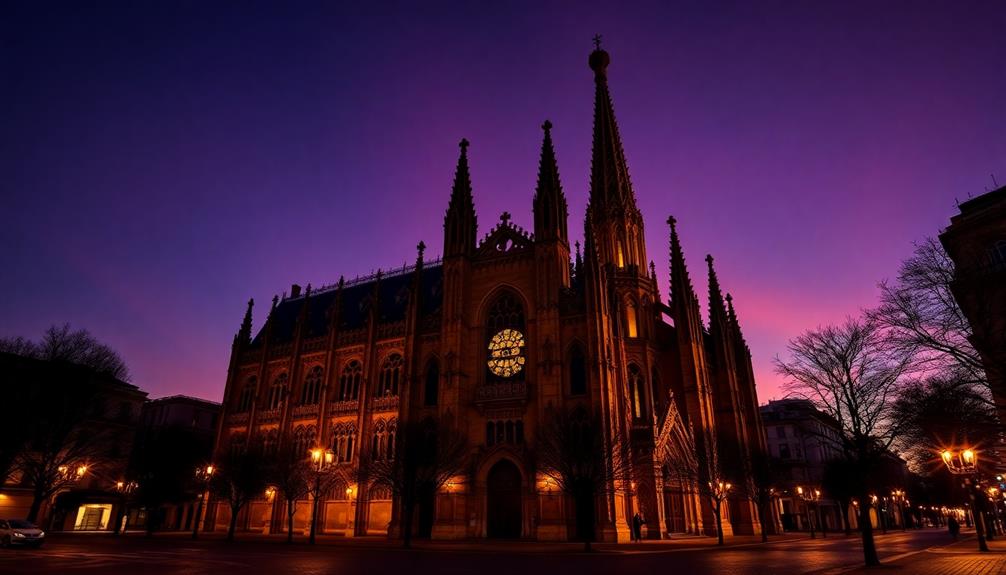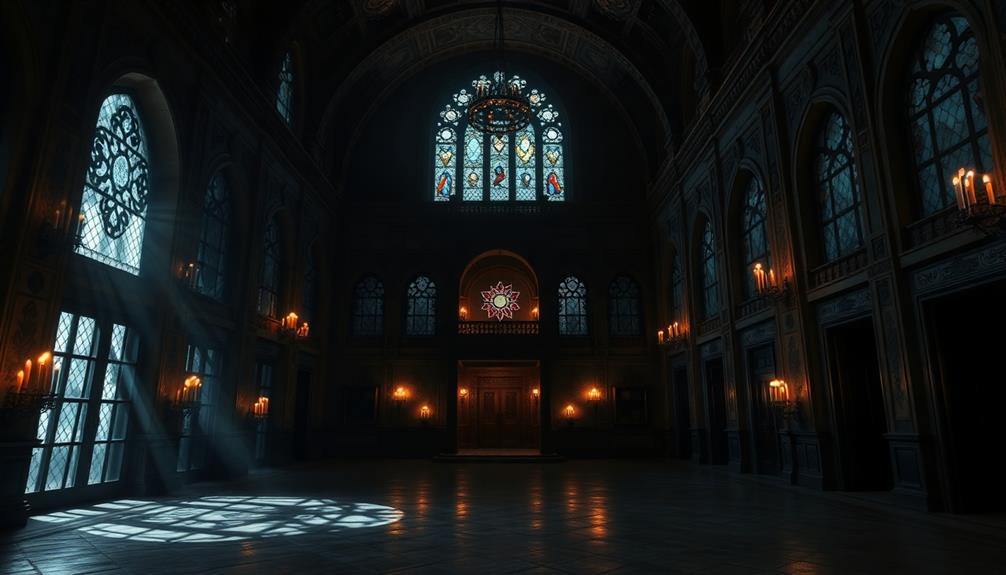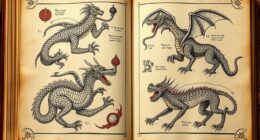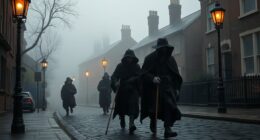At the Monastery of El Escorial, ghost monks unearth echoes of lost secrets and haunting legends. This UNESCO World Heritage site, constructed under King Philip II, holds tales of a spectral black dog and the restless spirits of royal wives. You might feel the chilling presence during your visit, especially on full moon nights. The eerie atmosphere, entwined with the monastery's rich history, invites you to confront your darkest fears. Each corner whispers stories of the past, urging you to uncover what lies beneath. Stay curious, and you'll discover even more intriguing secrets that await you.
Key Takeaways
- El Escorial is steeped in legends, including the haunting presence of a black dog believed to guard a gateway to hell.
- Monks at El Escorial reported hearing terrifying howls during prayers, contributing to the site's eerie atmosphere and supernatural reputation.
- The construction of El Escorial faced disruptions due to the haunting black dog, which affected workers' focus and morale.
- Local folklore associates ghostly apparitions with El Escorial, enhancing its mystique as a site of spiritual turmoil and dark secrets.
- The monastery's library houses banned titles, reflecting the tension between authority and knowledge, hinting at hidden intellectual pursuits.
Historical Context of El Escorial

El Escorial stands as a monumental tribute to Spain's rich history, commissioned by King Philip II in the late 1500s. This royal monastery was built to express gratitude to God and to symbolize Catholic strength against the rising tide of Protestantism in Europe, a time when religious tensions were mirrored by rising tensions among major powers across the continent.
Nestled in a village that once housed an old coal mine, local folklore suggested that this site was a gateway to hell. This mystique adds layers to the profound significance of El Escorial.
As you explore the monastery, you'll find it serves as the final resting place for Spanish kings and queens, showcasing the historical importance of royal lineage and heritage. The building itself represents a unique blend of religious, cultural, and architectural elements, making it a UNESCO World Heritage Site.
While you walk its halls, keep in mind the challenges faced during construction, including haunting local legends. Workers and monks reportedly encountered a terrifying black dog, adding an eerie dimension to the site's history.
El Escorial isn't just a monument; it's a deeply woven tapestry of faith, power, and the supernatural, reflecting the turbulent times of its creation in Spain.
Construction Challenges and Myths

As you explore the construction of El Escorial, you can't ignore the haunting legend of the black dog that plagued workers at night.
This eerie presence not only caused fear but also led to significant disruptions in the construction process.
The interplay of supernatural challenges and local folklore reveals how deeply these myths affected both the laborers and the monastery's reputation.
Haunting Black Dog Legend
Construction of the Monastery of El Escorial wasn't just a monumental task; it was haunted by the legend of a nightmarish black dog. This creature reportedly harassed workers at night, causing fear and significant disruptions. Monks in the newly built church heard its haunting howls, which instilled dread and hindered divine services.
The legend of the black dog adds layers to the site's eerie reputation. Many believed it guarded a nearby coal mine, rumored to be a gateway to hell. Despite its eventual capture and display, tales persisted about the dog being a devil's messenger, waiting to claim King Felipe II's soul.
The haunting of the black dog contributed to local folklore, reflecting cultural attitudes toward good and evil. You might think about the implications of such stories on the construction process. Consider these aspects:
- The psychological impact on the workers and monks.
- The intertwining of myth and reality in historical narratives.
- The lasting influence of folklore on the monastery's mystique.
Ultimately, the legend of the black dog remains an enduring part of El Escorial's dark charm, intertwining history and myth in a fascinating way.
Construction Disruptions Experienced
The legend of the haunting black dog didn't just add to El Escorial's eerie aura; it directly impacted the construction process. Workers faced significant disruptions from this spectral creature, which was said to guard a rumored gateway to hell near the site.
Fear spread among the laborers and monks, causing interruptions that hindered progress on the grand monastery. The dog's terrifying howls often echoed through the halls, so loud that they disrupted divine services in the newly built church, illustrating how deeply supernatural beliefs influenced the construction efforts.
As the haunting continued, the atmosphere grew tense, and the project faced delays. Eventually, after much distress, the black dog was captured and killed, with its body displayed to dispel fears of its supernatural nature.
This event marked a turning point in the construction of El Escorial, allowing work to resume more smoothly. However, the legend didn't fade; rumors persisted that even King Felipe II was tormented by the dog's barking in his final days.
Consequently, the haunting black dog not only embodied local folklore but also left its mark on the very foundation of El Escorial, intertwining myth with history.
Supernatural Construction Challenges
Amid the monumental task of building El Escorial, workers faced more than just physical challenges; they grappled with supernatural phenomena that tested their resolve. The atmosphere surrounding the construction site was charged with fear, which may have been alleviated by emphasizing gratitude to enhance professional growth, as seen in Abraham's Business Success Principles.
One of the most notorious disturbances came from a terrifying black dog that haunted the construction site at night. This spectral beast disrupted laborers, sowing fear and chaos among them.
The legend surrounding the black dog claimed it guarded an old coal mine, rumored to be a gateway to hell. This eerie atmosphere not only affected the builders but also troubled the monks in the newly constructed church, who reported hearing the beast's chilling howls during divine services.
The haunting presence of the black dog was thought to inhibit productivity, creating an unsettling environment. To combat the fear, the dog was eventually captured and strangled, with its display intended to prove its common nature. Yet, the haunting persisted, and myths suggested the creature awaited to claim King Felipe II's soul as a messenger of the devil.
- Workers reported sightings that disrupted their tasks.
- Monks experienced howls that interrupted their prayers.
- The dog's legend lingered long after King Felipe II's death.
The Role of Kings and Queens

Throughout history, monarchs have played a pivotal role in shaping the cultural and political landscape of Spain, and the Monastery of El Escorial stands as a tribute to their influence. This magnificent site serves as the final resting place for Spanish kings and queens, illustrating the significance of lineage and royal heritage.
| Role | Burial Location | Significance |
|---|---|---|
| Kings | Left side of the Pantheon | Represents royal lineage |
| Queens (Mothers) | Right side of the Pantheon | Signifies maternal heritage |
| Queens (without heirs) | Special Pantheon | Highlights unique royal status |
| Duration in Pudridero | 30-40 years | Reflects traditional customs |
The burial practices at the Monastery of El Escorial reveal the deep connection between monarchy and Catholicism, particularly during Philip II's reign. Each monarch's placement in the Octagonal Pantheon not only signifies their status but also embodies the aspirations of a kingdom endeavoring to maintain its power against Protestant influences in Europe. The careful arrangement and unique customs surrounding these burials underscore the cultural importance of royal legacy in Spain.
Architectural Significance

Beauty and grandeur define the architectural significance of the Monastery of El Escorial, a stunning fusion of a royal palace and a monastery. Built during the reign of King Philip II in the 16th century, El Escorial is a prime example of Spanish Renaissance architecture, reflecting the cultural aspirations of the Spanish monarchy.
Its unique ground plan, shaped like a grill, honors San Lorenzo and symbolizes the suffering he endured, as well as commemorating the Spanish victory over French forces at the Battle of St. Quentin.
El Escorial contains over 3,000 rooms, showcasing its multifaceted purpose. Key architectural features include:
- The imposing basilica, designed to inspire reverence and awe.
- The royal pantheon, a solemn resting place for Spanish monarchs.
- The beautifully landscaped gardens, offering a serene escape from the monumental structures.
Designated as a UNESCO World Heritage Site, El Escorial stands not only as a monument to architectural prowess but also as a repository for important cultural artifacts.
Its grandeur invites you to explore the layers of history and artistry that define this remarkable site.
The Enigmatic El Escorial Library

You might find it fascinating that the El Escorial Library holds a collection of banned titles, reflecting the complex intellectual landscape of its time.
With a systematic organization method, it stands as a demonstration to Philip II's dual role as a conservative ruler and an inquisitive mind.
This library not only preserves important manuscripts but also invites you to explore the rich cultural heritage of Spain.
Banned Titles Collection
The El Escorial Library stands as a remarkable tribute to the complexities of censorship and intellectual freedom in 16th-century Spain. Within its walls, you'll discover a fascinating banned titles collection that challenges the conservative norms upheld by Philip II.
This library isn't just a haven for religious texts; it harbors a wealth of philosophical and scientific writings that reveal a duality in the king's character—both orthodox and intellectually curious.
Here are a few highlights about the banned titles collection:
- Censorship vs. Curiosity: Many works deemed heretical by the Catholic Church were nonetheless preserved, showcasing a tension between authority and knowledge.
- Cultural Heritage: The library acts as a repository for Spain's intellectual pursuits during the Renaissance, reflecting the era's evolving thought.
- Diverse Manuscripts: The collection includes everything from theological debates to avant-garde scientific theories, offering a glimpse into the broader intellectual landscape of the time.
As you explore the El Escorial Library, you'll sense the enduring impact of these banned works and their subtle rebellion against the constraints of their time.
Systematic Organization Method
A systematic organization method distinguishes the El Escorial Library, reflecting Philip II's progressive vision for knowledge preservation. When you step into this remarkable library, you'll notice it's not just a collection of books; it's a meticulously structured repository of ideas.
Philip II implemented an innovative cataloging system that showcased modern traits, making the library an early example of a national library in Spain. As you explore, you'll see how this organization reveals complexities in Philip II's reign.
The library houses many banned titles, offering insights into his curious engagement with diverse philosophies and ideas, countering his conservative reputation. Each manuscript and work of art is strategically placed, emphasizing the importance of literature during the Renaissance in Spanish culture.
This systematic method isn't just about order; it serves as a symbol of the Spanish monarchy's aspirations for intellectual pursuits. Today, the El Escorial Library stands as a historical and cultural gem, reminding visitors of the value placed on knowledge and the importance of preserving it for future generations.
You can feel the weight of history and the thoughtful organization that makes this library a beacon of intellect.
Intellectual Pursuits Reflection
Stepping into the El Escorial Library feels like entering a sanctuary of thought, where the whispers of history echo through the meticulously organized shelves. This first national library of Spain, nestled within the El Escorial Monastery, reflects the complex character of Philip II. His collection reveals a monarch deeply engaged in intellectual pursuits, balancing conservatism with a thirst for knowledge.
The library's systematic organization showcases modern traits and the Renaissance's reverence for learning, paralleling the need for awareness in various health issues, such as the importance of early detection in conditions like breast cancer.
You'll find:
- Banned titles that challenge conventional thought.
- Manuscripts and artworks underscoring Catholic ideology.
- Notable literary works that echo Philip II's reflection and transcendence.
As you explore, you realize that the library serves not just a practical purpose but also symbolizes the cultural aspirations of the 16th-century Spanish monarchy. Each corner of this architectural marvel invites contemplation, urging you to ponder how art and literature can elevate the human spirit.
Within these walls, the ghostly whispers of monks might reveal not only the past but also the timeless pursuit of truth and understanding. This library isn't just a repository; it's a reflection of the enduring quest for knowledge.
Legends of the Black Dog

Legends surrounding the black dog at El Escorial have captivated both locals and visitors for centuries. This spectral canine haunted the construction site, causing disruptions and instilling fear among workers and monks alike. Many believed the black dog was guarding a rumored gateway to hell, which only added to the challenges faced during the monastery's construction.
The situation escalated when the black dog was finally captured and strangled. Its body was displayed as proof of its mundane nature, intended to alleviate the fears it had instilled. However, the haunting didn't end there. Reports suggest that the barking of the black dog continued to torment King Felipe II in his final days, leading to beliefs that it served as a messenger of the devil, waiting to claim his soul.
Today, tales of the black dog remain a vibrant part of local folklore. They enhance the mystique of El Escorial, adding layers of cultural significance to this historic site.
Ghostly Tales of Royal Wives

Often, visitors report feeling a chill in the air when they wander through the halls of El Escorial, especially on nights illuminated by the full moon.
These ghostly tales of royal wives weave through the very fabric of this monumental site, echoing the lives of Philip II's four wives who are believed to haunt its corridors.
The allure of their spirits can be attributed to:
- Unresolved issues from their tumultuous marriages.
- The emotional weight of loss and loyalty felt by the royal family.
- The historical significance these women held within the Spanish monarchy.
Locals and tourists alike recount eerie sightings and experiences that deepen El Escorial's cultural mystique.
Legends suggest that the spirits manifest during full moons, embodying desires unfulfilled and connections never fully realized.
Each encounter serves as a reminder of their lives, intertwined with the history of Spain.
As you explore the monastery, you might just feel their presence, a haunting whisper from the past that carries the weight of royal secrets and histories long gone.
The ghostly tales of royal wives add an enchanting layer to the already profound atmosphere of El Escorial.
Mystical Experiences at El Escorial

At El Escorial, visitors often find themselves engulfed in an atmosphere rich with mystical experiences that transcend the ordinary. The site's energetic power is palpable, with oral traditions referencing twenty vortices symmetrically identified within the basilica. These vortices invite you to explore your inner self, encouraging transformative experiences that echo the legacy of various civilizations.
You might also be intrigued by the apparitions of the Virgin of El Escorial, which have been reported since 1980. Many believe the miraculous fountain water associated with these sightings brings peace and healing. Furthermore, the intertwining of Philip II's faith and astrological beliefs adds a fascinating mystical layer to the history of El Escorial.
| Element | Description | Significance |
|---|---|---|
| Vortices | Twenty energetic points | Reflects spiritual energy |
| Virgin Apparitions | Sightings since 1980 | Represents peace and miracles |
| Folklore | Haunting by Philip II's wives | Enhances the site's mystery |
As you wander through El Escorial, you'll certainly feel the weight of history and the whispers of its mystical past.
Visitor Engagement and Experiences

Exploring El Escorial offers more than just a glimpse into its mystical past; it invites you to engage directly with its rich tapestry of history and legend. As you wander through this architectural marvel, you'll uncover a wealth of opportunities to deepen your understanding of its eerie charm.
By participating in private tours, you'll gain in-depth insights into El Escorial's cultural and historical significance, all while delving into its ghostly legends. Guided explorations reveal key architectural features and the haunting stories that accompany them, enriching your visit with enthralling narratives.
You won't want to miss the acoustically designed Chamber of Secrets, historically used for clandestine conversations, which enhances the allure of its ghostly tales.
Here's what you can look forward to during your visit:
- Engaging narratives that bring El Escorial's history to life.
- Unique architectural features that showcase the monastery's grandeur.
- Breathtaking mountain views that provide a serene backdrop for exploration.
Whether you're a history buff or a paranormal enthusiast, El Escorial offers experiences that cater to your interests, ensuring a memorable journey into the heart of its haunting legacy.
Cultural Impact and Modern Reception

The ghostly legends of El Escorial regularly captivate visitors, blending history with the supernatural in a way that resonates deeply with modern audiences. You'll find stories of the black dog and the spirits of Philip II's wives enriching the site's allure. These haunting tales not only attract tourists but also reflect a cultural fascination with morality and consequence.
Cultural Impact of El Escorial's Legends
| Aspect | Description | Modern Relevance |
|---|---|---|
| Folklore | Local legends inspired by hauntings | Enriching cultural narratives |
| Moral Lessons | Cautionary tales highlighting actions | Reflecting contemporary themes |
| Celebrations | Halloween festivities inspired by lore | Showcasing ongoing cultural impact |
Interest in El Escorial's paranormal aspects serves as a reminder of historical legacies and the importance of moral conduct. The intertwining of history, spirituality, and the supernatural continues to resonate, making El Escorial a significant place for both reflection and celebration. As you walk its halls, you can't help but feel the weight of its stories, echoing through time and shaping local traditions.
Conclusion
In the heart of Spain, El Escorial stands as a tribute to history, mystery, and the supernatural. Did you know that over 200,000 visitors explore its hallowed halls each year, drawn by tales of ghostly monks and royal secrets? As you walk through its corridors, you can almost feel the echoes of the past whispering their stories. Whether you're seeking architectural wonders or ghostly encounters, El Escorial promises an unforgettable journey into the unknown.









